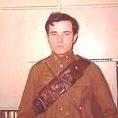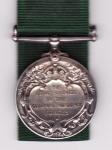-
Posts
1,784 -
Joined
-
Last visited
-
Days Won
3
Everything posted by Michael Johnson
-
Ancestry shows 44 Kenneth E Millers enlisted in the U.S. Army 1941-45. At least 18 of them are buried in Veterans' Graves.
-

WW1 trio
Michael Johnson replied to Noor's topic in Great Britain: Orders, Gallantry, Campaign Medals
His MIC shows his first theatre of war as France, from 8/7/15, which should narrow the search a bit. If he was a Territorial he didn't serve after 1917, as he doesn't have a new number (which would have told us his unit). -
The best route is to find a researcher at the National Archives to search for service papers. These will give a lot of useful information, and should also confirm which clasps (if any) he qualified for on the British Crimea. Armed with a full name and a birthdate, you can do genealogical research on the internet. You might even be able to establish a family connection. According to http://www.northeastmedals.co.uk/british_regiment/west_yorkshire.htm There is an almost even split between no clasps and Sebastopol only.
-
No battle honours between 1813 and 1915: Valmy Hondschoote Hohenlinden Caldiéro Lützen 1813 Vauquois 1915 La Somme You did your military service with your local regiment. I suspect you stayed with them if you made a career of it.
-

R:A:F Victory Medal search
Michael Johnson replied to christerd's topic in Great Britain: Orders, Gallantry, Campaign Medals
Post April 1, the lowest rank in the R.A.F. was Private. Medal Index cards aren't available for them online unless they had previous Army service. I believe that an OMRS Journal c. 1982 gave the serial number ranges, with some details for each. -

What is this star for?
Michael Johnson replied to Garth Thompson's topic in Great Britain: Orders, Gallantry, Campaign Medals
I looked into this once. Could it be that it was because it was the Presbyterian Scots who handed him over to Noll? Yep, that's it: http://www.skcm.org/SCharles/scharles_main.html -
I did some research for a lady whose grandfather was with the 3e BILA. He'd enlisted in the Navy, was convicted of theft, sentenced to five years in the BILA, deserted, married in England, and then during the First War surrendered himself to the French consul. He was returned to the 3e BILA, and was killed with them at Prosnes in 1917.
-
There are quite a few War of 1812 re-enactment units in Ontario, plus staff at various Forts. Peter and I are in different units, but both depicting the Royal Newfoundland Regiment. My group are not serious re-enactors, rather a branch of the Boy Scouts in Southern Ontario and NE U.S.A. We do two camps per year At Fort George in period uniform. The muskets fire caps. If the "soldiers" in the clip looked like boys, then it might have been The Scout Brigade of Fort George. If they were grown, then they would be re-enactors.
-
Peter probably has the unique distinction of being the only person to keep a Martini-Henry Mk.IV and bayonet in his residence room. There were some members of Theatre Mickities who wished that it had been used on Pete's room-mate, who wrote reviews for the college paper. Regarding cannon accidents, some years after I was in the Fort York Guard, one of them lost part of a hand, as he was firing a 19th century howitzer during a performance of the 1812 Overture at Ontario Place. The bets were that a piece of wadding had caught on a rough spot on the bronze and it had ignited the next charge.
-
I attended University of Toronto Faculty of Law. The large auditorium we used for classes was right on the curve of Queen's Park Crescent, perhaps 400 feet from where the 105s of the 7th Regiment R.C.A. lined up to fire salutes for the opening of the Legislature. I remember one day watching the non-Toronto students jump as the first round was fired. (It did sound as if a truck had hit the outside of the building, which had no windows). :cheers:
-
"Type" collectors have a lot to answer for ("Type" = "one of each medal/clasp") I've also heard that 30 odd years ago it wasn't unusual for dealers to sell the decorations separately from the medals. Definitely missing a Rakhsha Medal and Sangram Medal. Almost certainly missing a 25th Anniversary Medal and 9 Year LS. Possibly missing a Sainya Seva Medal.
-
There is a precedent. Those of the Metropolitan Police who received the 1887 Metropolitan Police Jubilee Medal got a bar dated "1897". I remember my articling student (a Naval Reserve officer) referring to the 1977 Jubilee as "the snivellers' medal" implying that if you whined to your CO enough you got put on the list. Of course that was back in the days when few wore more than an UNFICYP or UNDOF, and CD.
-
I think you have to bear in mind that when the first ribbons were authorized, there were only two: The Africa Star The 1939-43 Star The latter covered France 1940, Dieppe, Commando Raids, and everything else. Africa was the big show. I'm sure there was lots of rivalry between the 8th and 1st Armies, but for both of them, their fighting was a lot heavier than the earlier campaigns against the Italians, and doubtless they wanted some way to show it.
-

Cost of medals
Michael Johnson replied to muckaroon1960's topic in Great Britain: Orders, Gallantry, Campaign Medals
I do think that the centenary will result in many families trying to track down the medals that were sold off over the years. -

Medals Research possible?
Michael Johnson replied to Noor's topic in Great Britain: Orders, Gallantry, Campaign Medals
The 1901 census shows 25 Alfred Ledgers. I don't think the Special Constabulary Medal appeared in the London Gazette, so that option isn't available. -

WW1 Canadian KIA.
Michael Johnson replied to Chris Boonzaier's topic in Great Britain: Orders, Gallantry, Campaign Medals
The remaining GVR crosses were used up in the early days of the Second War. I have one to sn RCAF doctor killed in 1941 in a Hudson crash on Sable Island (F/L Frederick Judson Bell). He's buried in Toronto's Mount Pleasant Cemetery, not far from another Dr. Fred B. who was also killed in a Hudson crash - Dr. Fred Banting). -
Three countries officially named their Stars and Medals: Australia, India, and South Africa. Australian medals show serial number and name. For Army units the number will have a State prefix, e.g. N for New South Wales, V for Victoria, Q for Queensland. If the letter is followed by an X, then the soldier was in the Australian Imperial Force, ie volunteers for overseas service. No X indicated Militia. Indian Medals have regimental number, rank, name, regiment or corps South African medals have serial number and name.
-

South Africa ribbon bars
Michael Johnson replied to Noor's topic in Great Britain: Orders, Gallantry, Campaign Medals
It isn't uncommon to find bars lacking the War Medal ribbon, as it was authorized later than the Stars. Many men would have been demobilized before they had a chance to put it up. It also explains why the MiD is on the Efficiency (although I believe the Regulations called for it to be attached to the tunic). -
Phil was even able toget me Johnston's work record from the paper plant where he worked. Had an accident in 1944 and went on Workers' Compensation. I had a broken group to a Foord in the York Rangers - and an original in the 4th Bn. CEF. Colonial Auxiliary Forces non-swivel, and his Victory Medal. That would be a case where his double-time speeded up his medal.
-
Here's the only one I have. Capt. R.B. Johnston 51st Regiment. There's a bit of a story here. The 51st were the Soo Rifles, and Johnston was promoted to Captain and became the first Adjutant on the creation of the Regiment rank as of 15 November 1913. He had previously been in the 97th Algonquin Rifles, also in Sault Ste Marie. He was appointed a Tempy Captain CEF in 1917, but there are no online papers, and in fact he spent the whole of the war in the Soo. In 1917-18 he is shown as O.C. Canal Guards, and Sault St Marie Guards. There is a canal on the Canadian side of the border, but much amaller than the American locks. An interesting sidelight is that I had an inquiry about the Canadian Forestry Corps, as a pal on the 1914-18 Forum sent me the following: Captain J.H. Johnston was Robert's twin brother, and the Sergeant his brother as well.



